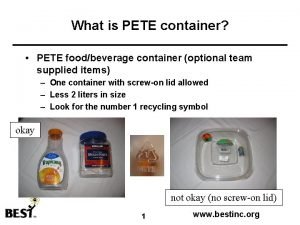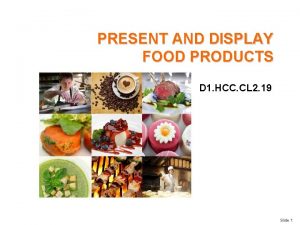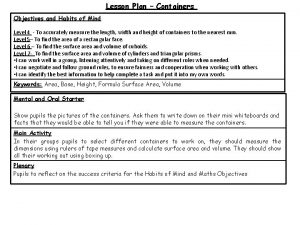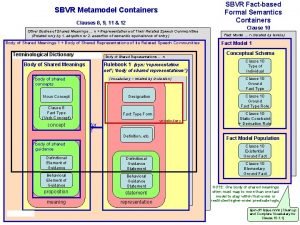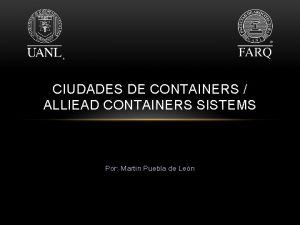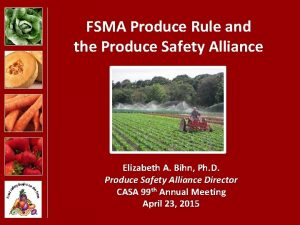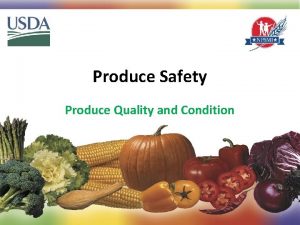Fresh produce is packed in containers of different





























































- Slides: 61


• Fresh produce is packed in containers of different sizes and shapes. • Each item is packed in a container that is suited to its size, shape and texture.

• The United States Department of Agriculture (USDA) is the federal agency that imposes standards for the quality and safety of foods, including fruit. • Both fresh and processed fruits may be graded by the USDA, however, grading is not mandatory.

• Grade categories for fresh fruits are different for each type of fruit. • Grade categories used for canned or frozen fruit include the following: – US Grade A or Fancy – US Grade B or Choice – US Grade C or Standard

• Bushel- a volume measure of 35. 24 liters or about 2200 cubic inches • Case- a box or container of varying size. Cases for produce may be cardboard, wood, plastic, or foam. • Crate- a wooden case.

• Count- a specific number of pieces of uniform-sized produce in a case or container. For example, a case of 140 count lemons has 140 uniform-sized lemons in each case. • Flat- A shallow single-layered case used for delicate products like berries and figs. • Lug- a large bulk-packed case.

• Peck- One-fourth bushel. • Gross weight- The total weight of a container and the product. • Net weight- the weight of the product without the package. • Tare weight- the weight of the package alone.

• • Citrus Fruits Apples & Pears Stone Fruits Berries Grapes Melons Tropical & Exotic Fruits

• Used for their flesh, juice, rind and/or zest (contains the highly flavorful oils)*Know for Test. • Available almost year-around. • Key indicator of quality is weight. Heavier Fruit generally has a greater juice content

• Once only a breakfast table staple, grapefruit has now become popular in salads, sauces and desserts. • Florida & Texas are the leading producers in the United States • At their peak September through June.

• Grapefruit fall into one of two categories based on the color of their flesh: white or pink. – Most popular white flesh: Marsh seedless grapefruit – Most popular pink flesh: Ruby Red grapefruit

• Tangerines are a part of a larger category of citrus fruits known as mandarins. • Mandarins are varieties of citrus fruits that have an easy to-peel skin. • The majority of mandarins in the U. S. are grown in Florida and are available October through May. The height of the season is November through January.

• Clementine is a popular variety imported from Spain. • Mineolas and tangelos are hybrids of tangerine and grapefruit.

• Two main categories of lime are Tahiti and Mexican. The Tahiti lime is a larger oval fruit with a thicker skin and dark green color (more commonly used in the U. S. ) The Persian lime is the most common Tahitian variety. • Mexican limes are smaller, lightered colored fruit with thin skins. The Key lime, a variety cultivated in the Florida Keys, is probably the best known variety in the Mexican category.

• Though not usually eaten as a lone ingredient, lemons are a staple in most kitchens. They are prized for their acidic juice and use as a garnish. • Look for lemons with fine textured skin and relatively heavy weight for their size. Deep yellow color is a sign of maturity and less acid. • California and Arizona provide most of the US production of lemons year-round.

• Some variety of orange is available every month of the year in the U. S. • Florida is the nation’s number 1 producer, followed by California and Arizona. • When choosing oranges don’t be fooled by the color. Green streaks in the skin are not necessarily a sign of under-ripeness. Bumpyskinned oranges are usually thick skinned, easier to peel and best for eating of hand. • Smooth skinned oranges are usually harder to peel therefore reserved for juicing.

• Valencia oranges are the most important variety of orange and are grown in both Florida and California. They are in season from February through October. • Navel oranges are named for the navel-like protrusion near their stem and are grown primarily in California. They have a slightly thicker skin, which makes them easier to peel. Navels are in season from November through May.

• Blood oranges are named for the deep red color of their flesh. They are originally from the Mediterranean island of Malta and lend their name to sauce Maltaise, a hollandaise sauce flavored with their juice. Blood oranges are in season from March through May.

• Apples and pears have been popular since ancient times. They grow abundantly in all regions of the world with a continental climate and store well without refrigeration. • They are a great source of dietary fiber.

• Most popular in the U. S. and grown in most parts of the country, but led by Washington state. • The most common pack for foodservice is a 40 pound case (approximately one bushel). • Apples are typically packed with a foam tray between each layer to prevent bruising. • Apples may be sprayed with a food-grade wax for appearance to prevent moisture loss.

• When selecting apples, look for a bright fresh appearance with appropriate color according to the variety. They should be firm to the touch and not mushy. The skins should be smooth and free of bruises. • Refrigerated and controlled atmosphere storage allows apples to stay at their peak for months.

• When choosing apples for a particular use, the texture and flavor of the variety of apple should be considered. – Firmer, tart apples are better for cooking, baking and applesauce. – Sweeter, softer fleshed apples are better for eating fresh.

• Eating Apples – Red Delicious – Mc. Intosh – Gala – Cortland

• Cooking and Baking Apples – Granny Smith – Northern Spy – Newton Pippin

• All Purpose Apples – Braeburn – Fuji – Golden Delicious – Jonathon – Jonagold – Rome Beauty

• Pears are a popular fruit because most pears can be stored for several months or longer under refrigeration. • Pears are commonly packed in a 45 -pound case (Approximately one bushel). They are packed either in trays or individually wrapped in paper to prevent damage.

• Ripe pears should yield slightly to a gentle squeeze. • Avoid pears that are scarred or have soft spots. • Many chefs prefer to buy immature pears and ripen the pears themselves. If pears are allowed to ripen on the tree, they tend to have a gritty texture.

• Bartlett • Anjou • Bosc • Comice • Seckel • Asian Pear (apple pear)

• Stone fruits are grouped together because of their pits or stones. They are often called tree fruits or drupes. • They tend to be at the peak of their relatively short season during the summer months.

• Fresh apricots are fragrant with juicy yellow fruit. • The season is June through July, therefore much of the apricot crop is canned, dried or preserved.

• The peach is called the “queen of fruits” because when at the peak of ripeness, no other fruit has such a wonderful, juicy, fragrant flavor as a peach. • Season is May to October. • Categorized into clingstone or freestone. • Clingstone- flesh is hard to separate from the pit (used for primarily for canning) • Freestone-pits are easy to remove (great for eating)

• Peaches are most commonly packed in a 20 pound case. • Look for peaches that are slightly firm because they ripen quickly. • Quality peaches should have a fragrant aroma. Avoid hard peaches with no give to their flesh, as well as green color or fruit with bruised or broken skin.

• Nectarines have a similar flavor and texture as peaches, but they don’t have the exterior fuzz that peaches have. • A lot of people believe that nectarines a cross between a peach and a plum. • Look for the same ripeness quality as peaches.

• Cherries are classified into sweet and sour. • Sweet (dessert) cherries are best for eating fresh • Sour (pie) cherries are best for cooking, baking and preserving. • Season for fresh cherries is June to August.

• Bing-red mahogany color and sweet, rich flavor • Rainier (Golden Bing)-yellow color, sweet delicate flavor and fine textured flesh. • Montmorency- main variety of sour cherry grown in the U. S. Noticeable for it’s bright red skin and juicy fruit.

• There are over 200 varieties of plums that all fall into 2 categories- European and Japanese. • European- oval in shape with bluish purple color (referred to as prune plums, because they are generally made for making dried prunes) • Japanese- come in a variety of colors—red, yellow, orange, green, but NOT purple.

• Traditionally available from May to October (but with shipments available from the Southern hemisphere make some varieties available during the winter months) • Look for plums that have good color for their variety and a firm texture that yields slightly to pressure.

• Pound for pound these are some of the more expensive fruit. *Test • They have a delicate texture and must be handled very carefully. • Have a relatively short shelf life and need to be used in a timely manner. • Most popular category of fruit because of the intense flavor and bright colors.

• Berry fruits are packed by volume rather than by weight. They are shipped in flats or single layer cases of dry pints of half pints. • Berries should be firm, plump, bright colored and free of dirt, insects or mold. • Watch for juice stains at the bottom of the containers as it is a sign of deterioration. • Should be refrigerated at temps 33 -38 degrees

• Blackberry- plump and shiny dark fruit with excellent juice content (Season: June-Sept) • Blueberry- have a patina or dull frosty appearance to their skin (Season: June-Sept) • Cranberry- fruit of an aquatic plant that grows in ponds. Have good shelf life (2 -3 months if refrigerated), freeze well, and are sturdy and easy to handle. (Season: Sept-January)

• Currant- small round fruit and intense tart flavor. Used for jellies, preservers, flavoring vinegars and sauces (Season: June-August) • Raspberry- come in red, golden and black varieties. Most delicate textured berry. (Season May to August) • Strawberry- have a distinctive heart shape, seeds on the outside and are packed with their hull intact. (Season: May-July)

• Table grapes is the term used for grapes that are eaten fresh rather than used for juice or raisins. • Majority of U. S. grapes come from California. • Traditional season for table grapes is summer and fall. • Unlike some fruits, the flavor of grapes doesn’t improve or ripen after they are picked.

• Look for compact bunches with plump fruit and good color for their variety. The stem is a good indicator of freshness; reject grapes with dry, brittle or moldy stems or with a large number of empty spots on the clusters. • Grapes are most often packed in a 22 pound case of bunches bundles in mesh bags.

• Thompson Seedless • Flame Seedless • Red Globe • Ribier • Concord • Corinth (champagne)

• Some of the less well known melons include: – Crenshaw- a large melon with striped, green skin and salmon colored flesh – Casaba- a melon with a tough, wrinkled yellow skin and white flesh. – Santa Claus or Christmas melon- large green oval melon with slightly netted skin and light colored flesh.

• The term cantaloupe has become the name for all varieties of muskmelons. Muskmelons are characterized by the netted or lace patter on their skin. • Deep orange- or salmon colored flesh and green inner rind. When ripe it is juicy, fragrant and very sweet. • Although the flesh of melons may soften if left at room temperature for a few days, they don’t ripen or get any sweeter after they are picked.

• Inspect the stem end of the cantaloupe. If there is an indentation where the stem was, the melon was ripe and pulled away from the vine easily. This state of ripeness is called “full slip. ” If there is no indentation or stem intact, the melon was unripe when picked and won’t improve in flavor. • Should be served chilled. Prime months: June through August.

• Ripe honeydew melons have a smooth creamy white rind, and pale green to white flesh. They are noted for their sweetness. • Honeydew melons are often picked before they reach the “full slip” stage and ripened by the wholesaler. • Will ripen at room temperature. Avoid melons with dark green streaks, which is a sign that they were picked way under ripe. • Can weigh as much as 7 pounds each. (At peak between May and November)

• There are hundreds of varieties of watermelon grown throughout the United States. • Shapes range from small round to oval to elongated. • The flesh ranges from light pink, to deep crimson, to golden yellow. • The quantity, size and color of the seeds also vary. • Due to their heavy size, watermelon is usually sold by weight. Many foodservice operations tend to prefer oblong-shaped melons that average 18 -22 pounds.

• Ideal storage temperature for watermelons is 55 degrees. It is important to avoid temperatures near freezing as they destroy the melon’s texture. • Regardless of the color of the outer rind, the best sign of ripeness is a pale yellow underside.

• Many of the fruits used in commercial kitchens are grown in tropical climates, such as the Caribbean, South or Central America, the South Pacific, or Asia, and imported to this country. • Bananas and pineapples are tropical fruits that are now considered kitchen staples. • This group of fruits will be discussed more in depth.

• A large number of fruits can be preserved by drying. Examples: – Raisins (dried grapes) – Sultanas (dried greed grapes) – Prunes (dried plums) – Dried currants – Dried apricots – Dried cherries (there are many more)

• Used in a variety of dishes including breads, pastries, sauces, salads and breakfast items. • Some dried fruits are treated with sulfur dioxide to preserve their color and to stop spoilage. • Keep dried fruits in a sealed container to preserve their flavor. • Dried fruits are often rehydrated or moistened before using.

• Canned fruits are usually packed at the peak of ripeness, so their flavor is consistent all year long. • They are often more economical than fresh fruits and require less labor. • Commonly canned fruits are peaches, pears and sour cherries.

• When choosing can fruit products, the main consideration is the liquid in which the can is packed. – Water packed- retains more of the fruits natural flavors and has fewer calories (than syrup packed fruits) – Syrup packed- always sweet, less likely to be broken or crushed. Heavier syrups are used to preserve the shape of more delicate fruits

• Canning fruit requires heat, essentially cooking the fruit, while frozen fruits often have a flavor advantage, because it retains more of the flavor of the fresh fruit. • Fruits are usually individually quick frozen (IQF) so that they retain their original shape.

• Hybrid- the offspring of two different plant varieties. Often hybrids are bred to produce a new, exciting fruit or a more disease resistant plant. Exa le: p m Kiwi plus Grape Equals Kiwiberry

Selecting and Preparing Fruits • How do you select a quality fruit? – Appearance, feel, smell, weight • What are the characteristics you want to consider? • • Color Firm Texture Smooth skin Dense (heavy for size) Free from bruises No decay Smells good

Selecting and Preparing Fruits • Why is it important to wash fruits before eating them? • Wash off pesticides and waxes • Why do most fruits turn brown when they are cut? • Oxidation or enzymatic browning • How can you prevent fruit from turning brown after it is cut? • Dip them in a citrus juice or liquid ascorbic acid-acidulation (most commonly done with lemon juice) with

Selecting and Preparing Fruits • What does it mean if a fruit is seasonal? • Grown and harvested during a certain season. • Why is it a good reason to buy seasonal fruits in season? • Lower cost, plentiful, and quality is better • How long will most fruit last after it is picked? • 1 week • What are some ways to preserve fruits? • Jam, jelly, canned, syrup, juice, and frozen

Selecting and Preparing Fruits • When selecting fruit at the store, what should you consider when deciding what form to buy? • Your intended use and price • Why are some fruits picked ripe? • They ripen best on the vine or tree; Don’t ripen well off the tree • Which fruits are generally picked ripe? • Oranges, apples, grapefruit • Why are some fruits picked when they are green or unripe? • Ripen well after they are picked; may fall off the tree if you wait and will get bruised
 Why do different atoms produce different colors
Why do different atoms produce different colors Generates fresh produce and other farm products
Generates fresh produce and other farm products Generates fresh produce and other farm products
Generates fresh produce and other farm products Generates fresh produce and other farm products
Generates fresh produce and other farm products Returnable containers accounting
Returnable containers accounting Module 1. stl sequential containers
Module 1. stl sequential containers Applications of boyle's law in real life
Applications of boyle's law in real life Opa
Opa Java swing graphics
Java swing graphics Four containers were filled with warm water
Four containers were filled with warm water Pete and pete container
Pete and pete container Java swing container
Java swing container Baie container
Baie container What goes in black pharmaceutical waste containers
What goes in black pharmaceutical waste containers Linux containers (lxc)
Linux containers (lxc) Containers for change
Containers for change Linux sgx
Linux sgx Ancient greek containers
Ancient greek containers Self sealability test for closures
Self sealability test for closures Associative containers
Associative containers Rigid sterilization containers
Rigid sterilization containers Liquid is pouring into a container at a constant rate of 20
Liquid is pouring into a container at a constant rate of 20 Anchor container security
Anchor container security Hypergraph containers
Hypergraph containers Quantifiers and containers
Quantifiers and containers What is food accompaniment
What is food accompaniment Clarity of aqueous extract test
Clarity of aqueous extract test Containers as a service
Containers as a service Hpe greenlake containers
Hpe greenlake containers Windows perflogs
Windows perflogs Resa containers
Resa containers Containers lesson plan
Containers lesson plan Closest packed structures
Closest packed structures Hematocrit measures
Hematocrit measures Diamond structure apf
Diamond structure apf Steep sided volcano made of loosely packed tephra
Steep sided volcano made of loosely packed tephra Pram algorithm for prefix sum
Pram algorithm for prefix sum Closed packed position of hip
Closed packed position of hip Packed bed absorption tower
Packed bed absorption tower Close packed direction
Close packed direction Closely packed elongated cells with corners thickened
Closely packed elongated cells with corners thickened An enzyme- packed wrecking balls of the cell.
An enzyme- packed wrecking balls of the cell. Steep-sided volcano made of loosely packed tephra
Steep-sided volcano made of loosely packed tephra Packed cell volume
Packed cell volume Furuc
Furuc Epithelial tissue
Epithelial tissue Free body diagram egg falling
Free body diagram egg falling Bioreactor applications
Bioreactor applications Density of air
Density of air Polycrystalline solids
Polycrystalline solids Resting knee position
Resting knee position Mchc low means
Mchc low means Hematocrite
Hematocrite Lattice parameter of hcp
Lattice parameter of hcp Who packed your parachute poem
Who packed your parachute poem Close packed directions
Close packed directions Close packed direction
Close packed direction Gas liquid
Gas liquid Loose packed position
Loose packed position Ergun equation derivation
Ergun equation derivation Attribute packed c
Attribute packed c Pcv calculation formula
Pcv calculation formula










